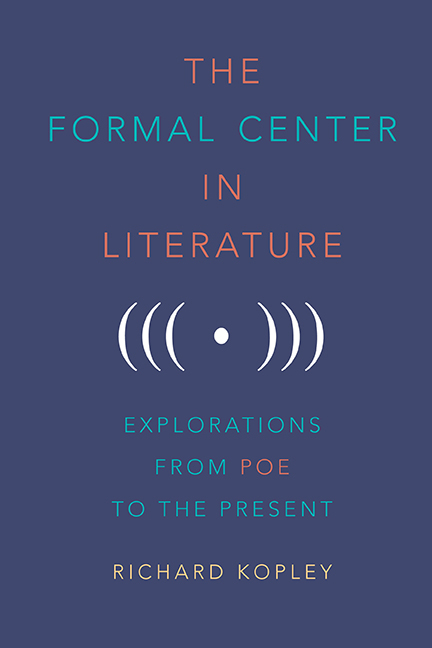Book contents
- Frontmatter
- Dedication
- Contents
- Acknowledgments
- Introduction
- 1 “Mournful and Never-Ending Remembrance” in Edgar Allan Poe's The Narrative of Arthur Gordon Pym
- 2 Retracing Our Steps in Edgar Allan Poe's “The Man of the Crowd”
- 3 “Scrutinizing the Parchment More Closely”: The Form of “The Gold-Bug” and Its Relationship to That of the Dupin Tales
- 4 Form and Reform in Nathaniel Hawthorne's “Earth's Holocaust”
- 5 The Circle and Its Center in Herman Melville's “Bartleby, the Scrivener”
- 6 Chiasmus in Henry David Thoreau's Walden
- 7 The Mythological Centers of Lewis Carroll's Alice Books
- 8 Table as Text in James Joyce's “The Dead”
- 9 The Structure of Sherwood Anderson's “Hands”
- 10 The Architecture of Ernest Hemingway's “The Three-Day Blow”
- 11 Balance in Dashiell Hammett's The Maltese Falcon
- 12 Framing Caesar in Raymond Chandler's The Big Sleep
- 13 The Ridge of the Domino in Patricia Highsmith's Strangers on a Train
- 14 The “X in the Air” in Joyce Carol Oates's “Where Are You Going, Where Have You Been?”
- 15 The Hybrid Center of Zadie Smith's White Teeth
- Notes
- Bibliography
- Index
2 - Retracing Our Steps in Edgar Allan Poe's “The Man of the Crowd”
Published online by Cambridge University Press: 14 June 2019
- Frontmatter
- Dedication
- Contents
- Acknowledgments
- Introduction
- 1 “Mournful and Never-Ending Remembrance” in Edgar Allan Poe's The Narrative of Arthur Gordon Pym
- 2 Retracing Our Steps in Edgar Allan Poe's “The Man of the Crowd”
- 3 “Scrutinizing the Parchment More Closely”: The Form of “The Gold-Bug” and Its Relationship to That of the Dupin Tales
- 4 Form and Reform in Nathaniel Hawthorne's “Earth's Holocaust”
- 5 The Circle and Its Center in Herman Melville's “Bartleby, the Scrivener”
- 6 Chiasmus in Henry David Thoreau's Walden
- 7 The Mythological Centers of Lewis Carroll's Alice Books
- 8 Table as Text in James Joyce's “The Dead”
- 9 The Structure of Sherwood Anderson's “Hands”
- 10 The Architecture of Ernest Hemingway's “The Three-Day Blow”
- 11 Balance in Dashiell Hammett's The Maltese Falcon
- 12 Framing Caesar in Raymond Chandler's The Big Sleep
- 13 The Ridge of the Domino in Patricia Highsmith's Strangers on a Train
- 14 The “X in the Air” in Joyce Carol Oates's “Where Are You Going, Where Have You Been?”
- 15 The Hybrid Center of Zadie Smith's White Teeth
- Notes
- Bibliography
- Index
Summary
I PROVIDE THREE CHAPTERS in this volume on Poe's fiction not only because I am a Poe scholar, but also because he regularly provided framed centers. Poe had a very strong sense of the symmetrical form of his fiction. I will focus in this chapter on an increasingly studied tale, one about supposed unreadability.
Even as the mysterious “man of the crowd” wanders through London, from the “D—— Coffee-House” back to what is now called the “D—— Hotel,” we as readers wander through the 1840 tale “The Man of the Crowd,” from the German book at the beginning that “does not permit itself to be read”—“er lasst sich nicht lesen”—back to that same book at the ending and that same quotation (M 2:506–7, 515). Scholars such as Ray Mazurek, Kevin Hayes, and Brett Zimmerman have noted the symmetrical verbal pairing. Steven Rachmann notes, too, the pairing of the title and epigraph with language at the close of the tale. And William Brevda observes another pairing, the phrase “absorbed in contemplation,” appearing shortly after the beginning and shortly before the end. Demonstrating the link between beginning and end, Zimmerman, Rachman, and Brevda note the marked circularity of the story. Scholarly recognition that the story is constructed of two halves encourages our seeking the remaining symmetries. Mazurek states that the first half, the exposition, consists of the first ten paragraphs and that the second half, the pursuit, consists of the second ten paragraphs. Other scholars have also remarked on the tale's two halves.
So, our job becomes identifying more fully the symmetrical phrasing in those two halves and thereby locating the center. We proceed through a cluster of phrases and clauses early on—“The Man of the Crowd,” “Ce grand malheur, de ne pouvoir être seul,” “er lasst sich nicht lesen,” “D—— Coffee-House,” “momently increased,” “absorbed in contemplation” (M 2:506–7)—on to “Their brows [those of the passers-by] were knit, and their eyes rolled quickly” (M 2:508) to “filthy garments” and “ragged artisans” (M 2:510) and then back through “filthy and ragged” “clothes” (M 2:511) to “his [the old man's] eyes rolled wildly from under his knit brows” (M 2:512) and finally back to a familiar cluster of phrases and clauses—“D—— Hotel,” “momently increasing,” “absorbed in contemplation,” “He refuses to be alone,” “He is the man of the crowd,” “er lasst sich nicht lesen” (M 2:515).
- Type
- Chapter
- Information
- The Formal Center in LiteratureExplorations from Poe to the Present, pp. 19 - 27Publisher: Boydell & BrewerPrint publication year: 2018



